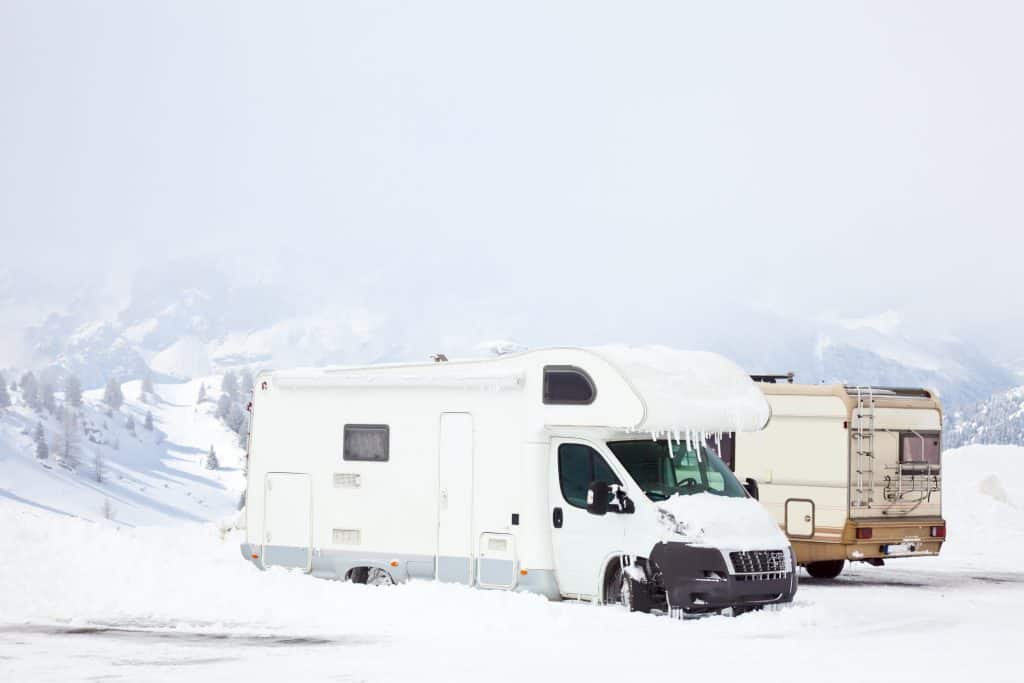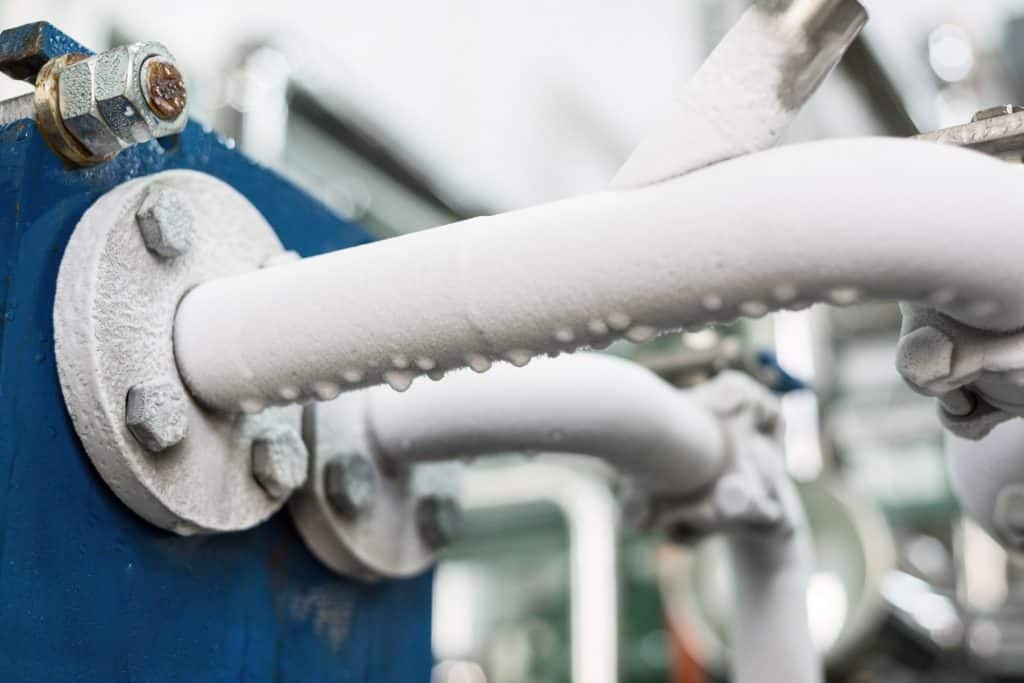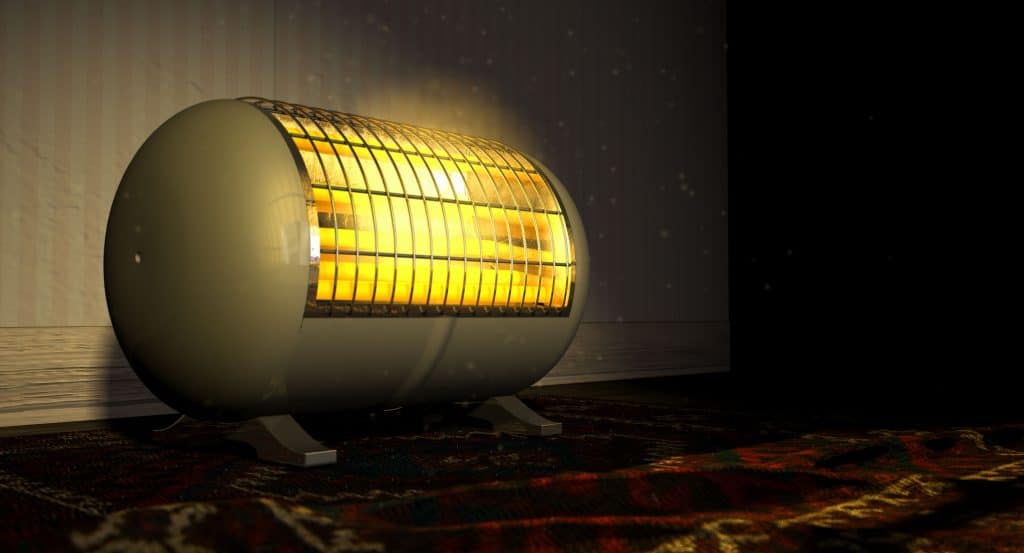
Arctic RV packages are some of the top-selling choices for outdoors people all around northern North America. Known for their comfortable, warm feel they are advertised to be perfect for sub-freezing temperatures, but what are the salesmen not telling us about these highly praised RVs? Today we will uncover the five biggest secrets salespersons would rather keep hidden from buyers. Let’s get started.
When presented by salespersons, the following important features of arctic package RVs are often kept hidden from buyers:
- Many RVs with “Arctic packages” have exposed or non-insulated water tanks under the trailer.
- Water lines are left without adequate insulation or heating
- Large holes allow mice to get in during the winter months.
- Inadequate cabin heaters can’t withstand the winter.
- The inadequately-insulated underbelly of the trailer can cause pipes to freeze and makes the interior of the cabin feel chilly.
Salespersons have a job to do; which is to make their RV look as appealing to the eye as possible and to veer your gaze away from the problems and blemishes behind the curtain that may arise after purchase.
With arctic packages, in particular, these problems may be hard to spot since they are only prevalent during the winter in severely low temperatures. Pay close attention to these important details to know how to make the best choice for your family winter adventure.
Four-Season RVs
If you love rving in the cold winter months, then it’s important to purchase a RV that can withstand the cold and keep you warm and toasty. When your trailer comes with an arctic package, it includes certain features.
- Efficient heating system
- Enclosed Underbelly
- Enclosed and heated tanks
- Extra Insulation
- Insulated pipes (PEX)
Other components may include are…
- Thermal windows (Dual pane windows)
- Insulated storage compartments
Check out some four-season campers that are great for camping in winter conditions: 11 Trailers made for cold winter camping
5 Things Your Salesperson Isn’t Telling You About Your RV’s Arctic Package
Non-Insulated Water Tanks

If a rv salesperson tells you that all is well under the hood, check under the hood twice. Salespersons tend to guide naive buyers to the most prominent features on the outside and within the cabin such as the nice furniture and appliances, but wouldn’t dare show you what things are like under the hood.
Sure, the nice counter tops and comfy beds can be a real price booster and may be well worth the money, but there is nothing like going on a camping trip with a frozen water tank to ruin your trip.
When water freezes, it expands which makes it extremely likely to burst the tank: creating a large hole in your wallet and your weekend. Consult with professionals and do your research about the specific model of RV you have your eye on to see if the water tanks are protected by automated water heating systems or insulation. Arctic packages should never have exposed water tanks.
Having a well-insulated water tank is so important that you’d be better off looking somewhere else if the RV you intend on buying does not meet these specifications. This is the first problem to watch out for by far, on which your entire trip depends.
Some RV dealers tend to use sales gimmicks such as telling the customers quickly that the water heaters are good in temperatures below 30 degrees Fahrenheit. If you are paying attention, this should stand out to you as a red flag. Don’t fall for sales gimmicks.
Do your research thoroughly and equip yourself with the knowledge of the water heating specs of the particular model of RV you wish to buy.
A great water heater will have the option to heat itself and be in an enclosed space, such as in the back compartment. Ask the salesperson specifically about how the water heater keeps the tanks from freezing in the winter.
Based on their response, make the judgment of whether or not this RV is worth it. If the water heater is ill-equipped with what it needs to survive the winter, drop it and move on to another one immediately.
If your RV doesn’t have proper water tank insulation or a heating apparatus, take a look at the solutions section up ahead. If you absolutely cannot part with your specific arctic package RV, even though it doesn’t have the proper water tank heating features, there are some alternatives.
Non-Winter-Proofed Water Lines
A salesman may say your RV will be able to handle the cold just fine, but you really don’t know how cold he or she is referring to. Many arctic package RVs are built for all seasons but are advertised specifically to cater to campers who presumably love camping during the winter and are in areas where temperatures drop to subfreezing.
Frozen plumbing and water lines are a complete nightmare for anyone out in the cold. Without water to drink from, to wash hands, and brush your teeth with, your family outing will be cut extremely short. In temperatures as low as the teens or low twenties, water pipes are at great risk without insulation.
Check all the pipes and water systems to make sure that they are well insulated with foam tubing and heat tape. Some RVs come with self-heating electric hoses that are perfect for the job. However, if the water lines or greywater lines are exposed to the cold, you may want to move on to other RVs before making a final decision.
Talk to your salesperson seriously about just how insulated the pipes and hoses are. Ask questions like what do the waterline hoses on this RV use to stay insulated? May I see the hoses for myself?
Take the time to inspect them yourself and determine whether or not they meet the standards of insulation otherwise you will be in for a short, miserable trip.
Large Holes

One complaint that often comes up after an RV has been in use for a while and is due for cleaning is little furry invaders.
Mice have posed a problem since the time of Adam and Eve. Especially during the winter seasons, when the mice are looking for any nook or hole to crawl into to escape the cold, mice become quite an issue. They will be desperate to find any place to hide for the winter and will be scrambling to get in.
Mice and rats leave behind a mess of droppings and are known to chew on wires, hoses, and sealants. One mouse or rat can be a total nightmare if allowed entrance into your RV.
Some common entry points in RVs include access points for electricity inputs, openings for water lines, gaps in poorly positioned slide-out sections, and sewer lines.
Once in, mice and rats don’t leave willingly. Plus, the smell they leave behind attracts other rodents into your RV. Check the underbelly of your RV for any hole the size of a nickel or bigger. Mice can get into holes this small just fine.
Pay close attention to all compartments around water lines, sewer lines, and generators for the most common entry points for mice. While this isn’t the biggest problem and can be prevented easily, we recommend observing all your options before buying an RV. Some RVs are better constructed and have fewer holes.
Continue reading to find some added solutions to your possible pest problem with basic hardware and cleaning supplies.
Inadequate Cabin Heating

During the winter season, it is obvious that the main issue for campers is heating. In most RVs the standard heating equipment is confined to propane-fueled furnaces and heat pumps.
Before any salesperson tells you that your arctic package RV will keep you nice and toasty throughout the winter, ask him or her about the temperature at which the heat pump operates and how much heat is generated by the furnace.
Heat pumps run on electricity and provide plenty of dry heat for little cost, but only when the temperature outside is above 40 degrees Fahrenheit. If you are planning on being out in sub-zero temperatures, it’s pretty obvious that your furnace is going to need to pick up the slack. Furnaces are the definitely safest route for heating your RV but more expensive and slightly outdated.
Furnaces are the main fuel burner in RVs by far. Depending on your RV, you may be burning 8 gallons of propane a day when the temperature drops below 25 degrees.
At $3.93 per gallon, fuel costs will be about $31.44 a day. If you plan on staying a week camping, that would land you at around $220 a week. Make sure you have adequate heating that will keep you warm in sub-zero temperatures before considering buying an arctic package RV.
If you find that your RV is not adequately equipped for the cold, take a look at the solutions section of this article to see solutions for the heating problem.
Inadequately-Insulated Underbelly
Bridges and RVs are similar in one particular aspect. With plenty of airflow underneath, both are bound to get really cold on top or inside. This is a simple fact that campers simply cannot avoid. If the undercarriage of your RV is not insulated with enough insulation, even when it is advertised to be an arctic package, you really should move on and look somewhere else.
While talking with the salesperson about a desired arctic package RV, talk to them about the particulars. Ask them questions like what is the insulation R-value for the underbelly? A quality arctic package RV’s underbelly will typically rest somewhere between R-4 and R-5.
What temperature does it have to be outside before the RV cannot keep itself warm? What kind of insulation is there under the RV?
Being familiar with the R-value scale of insulation will be very helpful. R-Value represents the capacity of insulating material to resist heat flow. A material with an R-value of 1-3 will be highly inadequate for an RV in the winter. Aluminum insulation has an R-value of around R2. If that insulation is backed by foam insulation and hardwood flooring, it may be within range to be arctic package worthy.
If the RV that you have your eye on comes with a skirt, you are in luck. RV skirts are an excellent feature for any average camper or motorhome, removing the possibility of cold air flow underneath the RV entirely ensuring that the space below the RV will remain on average 20 degrees warmer than the temperature outside.
For camping trips in temperatures below zero, it is highly recommended that you couple the skirt with good insulation.
Continue reading to find solutions to your insulation issue among other problems.
Solutions: If All Else Fails
Salespersons are there to help you make a purchasing decision, for better or for worse, but if you simply cannot find the right RV that fits all the specifications above, here are some simple solutions to fill in the gaps where necessary so you can pick that RV that is as close to your expectations as possible.
Let’s face it, perfect RVs are few and far between. The odds of finding an RV that fits all the specifications we’ve outlined thus far are pretty slim. So don’t hyperventilate if the RV you intend to purchase has a few flaws. Instead, continue reading to see great solutions to these problems to make your almost winter-proofed RV sufficient for the trip ahead.
Freezing Water Tank Solutions
If found in a situation where the RV you most desire doesn’t have the necessary heating apparatus to protect your water heater. There are a few suggested ideas given by avid campers that can still save the day but may prove an inconvenience nonetheless.
First, if your water tanks are located within the RV itself and are enclosed in the housing, a simple 40-80 watt light may be installed within the enclosed compartment keeping your water tanks quite warm.
If you do choose to go this route, make sure you install the light well away from the walls to avoid any possibility of a fire. Some RV enthusiasts have used this method to replace insulation altogether.
Another solution is to purchase RV heating pads.
We recommend UltraHeat or ThermaHeat pads. These heating pads are manufactured with a super-strong adhesive on one side, meant to stick to the bulk of water tanks to prevent freezing.
One notable feature that should not be overlooked is the thermostat that comes with the pads. While on the move, the temperature can be checked regularly with the thermostat and activated frequently.
Frozen RV Water Line Solutions
If for some reason you feel that you just can’t part with this particular RV despite the piping setbacks, there are ways you can insulate RV water pipes with simple pluming and insulating materials such as foam piping, heat tape, and duct tape.
The more expensive but equally effective alternative is replacing the hose altogether with a self-heating hose.
Take a look at this video of a ranch hand insulating an RV waterline to get a good idea of how to do it yourself.
Mice Invader Solutions
If you find your RV has been infested by mice and rats, it’s time to take action.
Make sure to check all possible entry points under the RV and behind cabinets, drawers, and appliances for any holes made for wiring and pipes. If there is a hole anywhere the size of a nickel or bigger, mice are bound to find it and make themselves a small home in your home away from home.
Many campers have found that these few solutions are simple and do the trick quite nicely.
The most effective solution known by campers to plug holes that are out of sight, such as those found in the underbelly, is to use spray foam or silicon sealant to fill in the gaps. This no-hassle solution effectively seals holes for years and is impenetrable for rats and mice, thereby making your RV rodent-free.
The second solution that I would recommend using for holes that are visible is to buy large packs of steel wool and stuff the holes in your RV with it. When packed in tightly, steel wool becomes a nearly impenetrable wall that mice and rats can’t chew through.
Inadequate Cabin Heating Solutions
If you realize that the RV you are looking at doesn’t have adequate heating but still is the most enticing to you and your family, there are some solutions to keep your family nice and comfortable during your sub-zero campout.
Try an indoor heater to give your RV that added boost of warmth that the furnace cannot. Having an extra source of heat in conjunction with your usual furnace will be more than enough during the winter season.
Many campers have found that the space heater is the best choice because it is electric and won’t run down your fuel reserves as quickly. With the capability to plug into wall outlets, the space heater is the safest and most reliable heater one can buy for their RV.
We quite like the Big Buddy propane heater on Amazon. While some may not enjoy the smell of propane, the Big Buddy heater is undoubtedly reliable and puts off a lot of heat rather quickly.
With the Big Buddy heater, one can choose to use one burner alone or both. Just be sure that if you do go this route you occasionally take a break from this heater or open a window to avoid filling your RV up with propane gas.
Inadequately Insulated Underbelly Solutions
A vital addition campers often make when planning on going on trips in the frigid cold, regardless if they have an arctic package or not, is a heavy EZ Snap RV skirt package. The job is rather simple and can be done in your front yard.
If you are planning on boondocking, it is highly recommended that you install an RV skirt first thing. You never know when the temperature will drop dramatically.
On average, the underbelly of an RV with a skirt will be 20 degrees warmer than the temperature outside. This fantastic investment will keep the RV cabin much warmer than without it, which translates directly into saved money on your part.
To install the RV EZ snap skirt one will need to measure out the perimeter of the RV and purchase the right kit according to how large the RV is. Afterward, you will need to follow the proper instructions for cleaning and installing quick snap tabs, all of which are found with the kit. For a step-by-step guide to installing an EZ Snap RV skirt, refer to the video below.
Related Questions
What is the best RV for sub-zero temperatures?
The Keystone Montana Fifth Wheel trailer is rated as the best RV for extreme cold. Being built to withstand the coldest living conditions, it is no surprise that this RV has a 15-year award of excellence.
With its luxurious and effective features such as In-floor water lines, dump valves and holding tanks that are insulated and enclosed, a heated underbelly that is also insulated and enclosed, a fully-vented attic system, and an auto-ignition 35,000 BTU furnace, there is no doubt that the Keystone Montana is the best RV for sub-zero environments.
Can an average RV survive extremely cold temperatures?
Average recreation vehicles are not built to withstand sub-zero temperatures but can, with added insulation and the sacrifice of running water, prolong their stay.
RV owners who choose to use their ill-equipped RVs in extremely cold climates are bound to face serious issues with water lines, sewage and grey water lines, water tanks, and more. It is highly recommended to all those who plan on buying an RV to find one that is specifically built for extreme cold.
